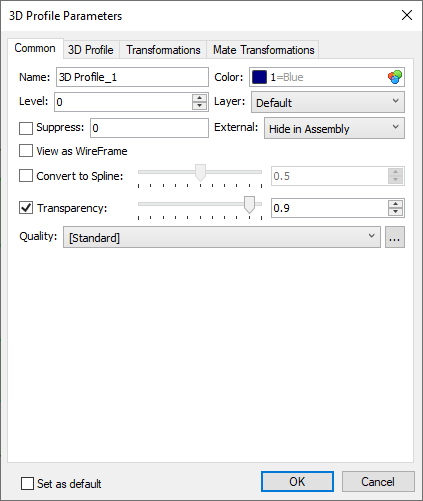Parameters Dialog of 3D Profile |
  
|
When creating a new profile its parameters dialog can be invoked using the option:
|
<P> |
Set entity parameters |
The parameters dialog for an existing profile can be invoked by double click ![]()
![]() on a profile or by selecting the
on a profile or by selecting the ![]() Parameters command in the contextual menu.
Parameters command in the contextual menu.
3D profile parameters dialog contains following tabs:
•Common
This tab is described below.
•3D Profile
This tab has the same functionality as the Parameters window has, when the 3D profile being created, and depends on the type of profile. Detailed descriptions are available in sections describing particular 3D profile types (by 2D elements, by 3D elements, projection, by surface unfolding) an in the Thickening Flat 3D Profiles section.
•Transformations
Contains information about transformations applied to the node. This tab has the same functionality as the Parameters window described for the Transformations command, except that it doesn't allow to apply symmetry and snap transformations to reference elements and doesn't contain information about Mate Transformations (it can be found in the separate tab of the dialog).
•Mate Transformations
Contains information about mate transformations applied to the node. This tab has the same functionality as the eponymous tab of the Parameters window described for the Transformations command.
Moreover, there is the Set as default checkbox located at the bottom of the dialog regardless of the active tab. If you enable this checkbox, parameters of the selected element will be applied as defaults for all elements of the same type created in future.
Common Parameters of 3D Profile

Name
Each element of a model have a unique name. User can type name manually. In this case the system checks if typed name is unique. If typed name is already assigned to another element in this document, the changes are not applied. If user didn't input a custom name, the system generates name automatically. More information about automatically generated names can be found in the Names Customization for 3D Elements chapter.
Color
The color of profile's representation in the 3D scene. Color can be selected in the same way as described in the Color chapter.
Level
This parameter is described in the Levels chapter.
Layer
This parameter is described in the Layers chapter.
Suppress
This option can be used for excluding a profile from the 3D model generation. Suppressed profile isn't displayed in the 3D scene. Enabling the Suppress checkbox excludes a profile from the model generation and sets the "1" value in the corresponding input box. Disabling the checkbox includes a profile into the model generation and sets the "0" value in the corresponding input box. Value may also be typed manually or defined by a real variable for controlling the suppression via Parametrization. A profile is suppressed if a variable's value isn't zero. Any whole values apart from zero are replaced by "1". Fractional values are not allowed.
Keep in mind, that suppression of a parent element leads to errors upon regenerating its child elements.
External
Two options are available in the drop-down list: Hide in Assembly and One Level. If the model is used as a 3D fragment, then profiles with One Level option applied are accessible in the assembly. The position of such profile is fully determined by the position of its 3D fragment. The parameters dialog of a 3D profile belonging to a 3D fragment in an assembly contains only one tab - Common. A name of a 3D fragment is added to a name of a profile as a prefix. The One level option can also be applied to profiles in assemblies, that will allow using such profiles in assemblies of higher level.
View as Wireframe
This checkbox controls the way of rendering the profile in the 3D scene. If it is disabled (by default), closed contours of a profile are filled in semi-transparent color. If it's enabled, only lines are displayed.
Convert to Spline
This parameter allows converting each contour of a profile into a single spline. The checkbox is disabled by default, so the conversion is not applied. Enabling the checkbox turns each contour of a profile into a single segment, with the intermediate vertices being removed. The approximation accuracy is controlled by the parameter in range from 0.0 (Rough) to 1.0 (Precise) using the slider or the input box. In certain cases, such 3D profiles are more suitable then those based on polylines (for instance, in the Loft operation).
This parameter does not affect combined profiles, whose several faces have adjoining edges (for example, if the profile is created from a set of adjoining faces).
Transparency
This parameter sets the degree of transparency of the profile contours filling in the 3D window. Lines of a contour are always non-transparent regardless of this parameter. The checkbox is enabled by default and the transparency value can be set in range from 0 (opaque profile) to 1 (fully transparent profile) using the slider or the input box. Disabling the checkbox makes profile fully opaque regardless of parameter's value.
Quality
Defines the quality of profile's representation in the 3D scene. The drop-down contains options similar to described in the Image Quality chapter.
If you want to use one of the system presets as a template for customizing user-defined parameters, select a preset in the drop-down and click the ![]() button located to the right side of the drop-down. The Mesh Quality dialog will appear with parameters of a selected preset. Enable the User Settings checkbox to edit them.
button located to the right side of the drop-down. The Mesh Quality dialog will appear with parameters of a selected preset. Enable the User Settings checkbox to edit them.
See also: